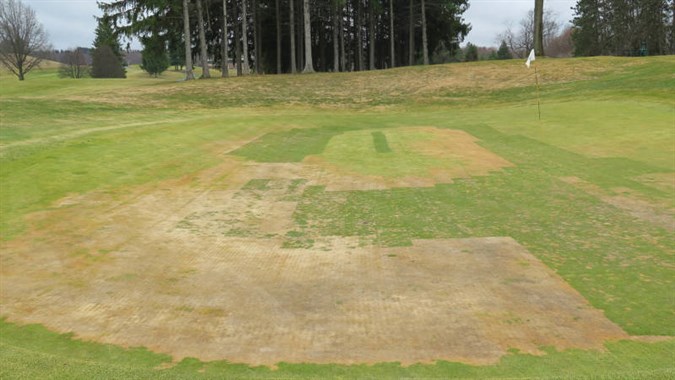Turf Advisory: Winter Kill Emerging on Courses

Winter kill damage seen on a green (USGA photo).
Article courtesy of the Carolinas Golf Course Superintendents Association
Some golf courses in the Carolinas are dealing with severe after-effects of harsh and prolonged winter cold. To date, most of the damage is showing up on greens where the impact ranges from minimal to almost complete loss of the putting surface. Generally, the hardest hit facilities are those without turf covers and those with newer greens and rhizomes too immature to withstand the sustained freeze.
But damage is showing up across the spectrum, from high-end private facilities to low-budget courses. “Even some superintendents who did their due diligence and used covers were not immune,” says turfgrass pathologist Dr. Bruce Martin from Clemson University. Martin is among a number of researchers and agronomists urging golfers to be patient over the coming weeks, and even months, as golf course superintendents learn the full extent of the damage and make repairs.
The condition, known as winter kill, affects warm-season grasses such as bermudagrass, which is the predominant turf on greens, tees, fairways, and roughs in the Carolinas.
What is certain, as is often the case with turf ailments, is that the impact will vary widely, sometimes from hole to hole on the same course and from one course to another. Greens have been affected in areas as geographically diverse as Greensboro, NC, and Charleston, SC. Some courses in the south end of Myrtle Beach, SC were under ice for a week in early January.
“Winter kill is seldom an ‘all or nothing’ phenomenon,” Dr. Bert McCarty of Clemson and Dr. Grady Miller of North Carolina State University say, in a joint statement. “Turf grown in stressful conditions such as shade, low mowing heights, and, or, with compacted soils typically is most susceptible. Secondarily, sites with standing water or powder-dry soil during a freeze experience a certain degree of winter injury. North facing slopes are also more susceptible to winter injury.”
|
|
Carolinas Golf Association agronomist Bill Anderson urges superintendents who see or suspect damage to prepare now for what may be a worst-case scenario. He and Dr. Martin anticipate demand for new plant material to regrow affected greens could lead to a shortage.
“Superintendents should be cautiously optimistic but go ahead and book the sprigs they might need on the high end of the spectrum,” Anderson says. “It if turns out their damage is not so bad then they can always revise their order down. But they should book a date now when they can close to re-sprig and get in line.”
USGA Green Section agronomist Patrick O’Brien says the harsh cold defied historical norms in many areas but also underlined the value of turf covers. O’Brien says research shows covers should be used when temperatures fall to 20 degrees or below. In many parts of the Carolinas, temperatures through the first week of the year dropped into single digits and never got above freezing.
“Most of the injury is at sites that typically don’t use covers,” he says. “Maybe this will change the perception for courses from Columbia (SC) to Charleston and up into Myrtle Beach that the winters don’t get cold enough to need covers. Events like this might only happen once every 20 years but courses will have to ask themselves how much risk and economic loss they can tolerate.”
O’Brien, like Anderson, urges clubs and courses to invest in turf covers against future damage from winter kill. “I know it’s not my money but at roughly $1,000 each, I think it’s a justifiable investment given the costs you incur when you’re forced to re-grass,” Anderson says.
Turf repairs or replacement may be necessary.
- Some areas of turf will recover slowly on their own.
- Areas where the turf is highly damaged will require new sod or sprigs.
- Turf repairs must be kept wet during the recovery time and golfer inconvenience may increase.
About the Carolinas Golf Association (CGA)
The CGA is a 501(c)(3) not-for-profit educational organization that was founded in 1909 to promote and to protect the game of golf in the Carolinas by providing competitions, education, support and benefits to golf clubs and golfers. The CGA is the second largest golf association in the country with over 700 member clubs represented by nearly 150,000 individuals.
The CGA annually conducts 48 championships and five team match competitions for men, women, juniors, and seniors. It also runs over 150 One-Day (net and gross) events as well as qualifying for USGA national championships. The CGA serves golf in the Carolinas with numerous programs such as: the USGA Handicap System; tournament management software and support; course measuring and course/slope ratings; agronomy consultation; answers about the Rules of Golf, Rules of Amateur Status, and Handicapping; Carolinas Golf Magazine; Interclub series; Tarheel Youth Golf Association; Carolinas Golf Hall of Fame; expense assistance for USGA Junior and Girls' Junior qualifiers from the Carolinas; and the Carolinas Golf Foundation (CGF). The CGF has distributed nearly $2,000,000 since 1977 to benefit Carolinas' golf initiatives including junior and women's programs.
For more information about the CGA, visit our website.
##30##

